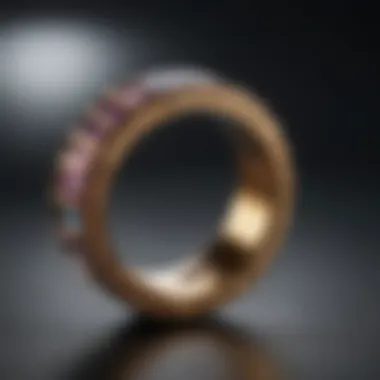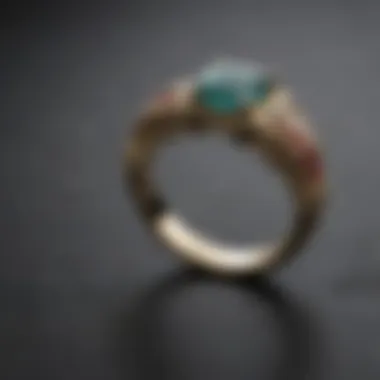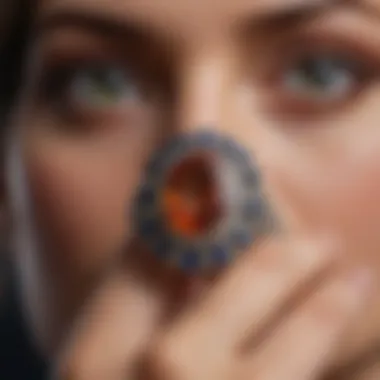Accurate Ring Size Measurement in Centimeters


Intro
In the realm of jewelry, particularly ring crafting, the importance of noting accurate ring sizes is profound. Ring sizes in centimeters can be quite different from traditional U.S. sizing, making precise measurement critical. This guide provides a thorough understanding of how to determine these sizes accurately, serves as a resource for novices, artisans, and gemstone lovers alike, and delves into the cultural and practical considerations that affect size choice.
Gemstone Overview
Understanding gemstones is essential for anyone engaged in jewelry making or collecting.
Definition of Gemstones
Gemstones are naturally occurring minerals, rocks, or organic materials that are prized for their beauty, rarity, and durability. Each gemstone has unique properties, contributing to its desirability in the market. From diamonds to emeralds, the spectrum of gemstones is vast and varied.
Classification of Gemstones
Gemstones can be classified into two primary categories: precious and semi-precious. Precious gemstones, such as diamonds, rubies, sapphires, and emeralds, are typically rarer and more valuable. Semi-precious stones, like amethyst, aquamarine, and garnet, are more abundant but can be equally stunning in their own right.
It is crucial to remember that value does not always equate to beauty; some semi-precious stones may outshine precious stones in terms of color and allure.
Historical Significance
The journey of gemstones is deeply entrenched in human history, and understanding this significance adds depth to their appreciation.
Origins of Gemstone Use
Humans have used gemstones for various purposes for thousands of years. Evidence suggests that they were revered not just for adornment but also as talismans for protection and luck. The earliest known jewelry dates back to 25,000 BC, featuring materials like bone, ivory, and shells, evolving over the years to incorporate gemstones as they became more revered.
Cultural Insights: Gemstones in Ancient Civilizations
In ancient cultures, gemstones held profound meanings. For example, in Ancient Egypt, turquoise was associated with protection and luck, while in India, different stones were believed to influence the wearer’s fate based on astrology.
The symbolism and significance of gemstones vary across cultures, reflecting their rich history and the profound beliefs societies held regarding their power and value. Understanding this context can help buyers and makers appreciate the stones they choose, beyond mere aesthetic qualities.
Culmination
This exploration into gemstones, their classification, and historical relevance sets the stage for understanding ring sizing. Knowing this backdrop is vital as one selects and sizes rings made from these gemstones. An insightful understanding of both can guide individuals in making informed decisions in their jewelry journey.
Understanding Ring Sizes
Understanding the complexities of ring sizes is essential for anyone dealing with jewelry, whether you are a buyer, a maker, or simply someone interested in gemstones. The accuracy of ring size measurement can greatly affect the overall satisfaction with a piece of jewelry. A correctly sized ring not only ensures comfort but also enhances the aesthetic appeal when worn.
The significance of accurate measurement lies in avoiding resizing mishaps. An incorrectly sized ring may lead to discomfort or dissatisfaction, prompting costly adjustments. When purchasing rings, mistakes in sizing can also lead to an emotional disconnect between the wearer and the jewel. Therefore, mastering the determination of ring sizes is a vital skill in the jewelry domain.
Moreover, an understanding of how different systems and cultural variations influence ring sizes adds layers of depth to this knowledge. Ring size systems vary across geographic boundaries and understanding these variances is crucial. By delving into this topic, one gains insight into how to navigate the complexities of ring sizing successfully, thereby enhancing the jewelry experience for oneself and others.
The Importance of Accurate Measurement
Accurate measurements are fundamental for any jewelry work. Rings that fit correctly are vital for both comfort and functionality. Measuring correctly prevents issues that could arise from too tight or too loose fittings, which could not only be bothersome but can also lead to loss or damage. Moreover, an accurate measurement fosters trust and satisfaction, particularly in commercial transactions. Customers appreciate precision and professionalism, which builds enduring relationships in the competitive jewelry market.
Standard Ring Size Systems
Standard ring size systems provide a framework for measuring rings, yet they differ based on region and purpose. Understanding these systems ensures that you will be able to effectively communicate sizing details with suppliers, makers, or buyers.
Metric vs. Imperial Systems


The debate between metric and imperial systems is prominent in the world of ring sizing. The metric system measures circumference in millimeters, while the imperial system uses inches or a series of numbers associated with specific sizes. Millimeters are widely regarded as a more precise measurement, allowing for fractional differences that can help in achieving perfect fitment. This aspect often makes the metric system more popular among gemstone enthusiasts and designers who prioritize precision.
On the other hand, the imperial system is prevalent in places like the United States, where many consumers are accustomed to these sizing numbers. Its familiarity makes it easier for local markets to engage with customers. However, conversions between these systems can often lead to inconsistencies, making it necessary for buyers to be diligent when traveling between systems.
International Size Variations
International size variations present additional complexity when determining ring size. Different countries have their own sizing systems, which can cause confusion during purchases or distributions. For example, sizes in Europe are often expressed in metrics, while countries like the US and Canada lean towards numerical sizes.
Understanding these variations allows individuals to communicate size specifications accurately across borders. This knowledge is notably beneficial for online shoppers who wish to avoid errors in ring size orders. Despite the potential for misunderstanding, the main advantage of international variations is that they allow for variety and adaptation within the market. It encourages cross-cultural jewelry exchanges, making the industry more dynamic and exciting.
Preparation for Measuring Ring Size
Accurate measurements are crucial when determining ring sizes in centimeters. Proper preparation sets the foundation for ensuring that the chosen size will be comfortable and suitable for the wearer. This section will discuss the tools needed and the timing for taking the measurements efficiently. Taking the time to prepare correctly avoids the common pitfalls of inaccurate sizing.
Gathering Necessary Tools
Measuring Tape
A measuring tape is an essential tool for measuring ring size. It is flexible and allows for easy wrapping around different finger sizes. The main benefit of using a measuring tape is its ability to provide accurate, direct measurements of the circumference of a finger in centimeters. You can find fabric or plastic measuring tapes, both of which tend to be user-friendly. They can conform to the shape of a finger, ensuring a snug fit when measuring.
However, there are some considerations. Fabric tapes can stretch slightly over time, potentially leading to minor inaccuracies if not handled carefully. Still, they are one of the most popular choices for many users due to their convenience and ease of use.
String or Paper Strip
String or paper strip methods are excellent alternatives to measuring tapes. This approach uses a piece of string or a strip of paper that is wrapped around the finger to determine size. One key benefit is accessibility; you can use items readily available in most households. A string is quite flexible and can also accommodate varying shapes, making it a good choice for those not familiar with precise measurement techniques.
The main disadvantage of this method is that it may not offer the same accuracy as a measuring tape, especially if the string or paper is not marked properly after measuring. The unique feature is that it allows for a quick and straightforward approach. Ensuring that the string or paper is not too tight during wrapping is vital to achieving genuine readings.
Caliper for Precision
If precision is your primary concern, a caliper is an excellent tool for measuring ring sizes. Calipers can provide highly accurate readings and are ideal for users who seek perfection in their sizing. This tool can measure the diameter of a finger directly, ensuring that no elasticity or stretch is factored into the measurement.
While calipers are beneficial for providing accurate measurements, they may require a little more skill to use than tape or string. A caliper's main drawback is that it is not as accessible as other options. It requires careful handling to take correct readings. Nevertheless, for those needing exact sizes, the advantages of using a caliper often outweigh the complexities.
Choosing the Right Time for Measurement
Time of Day Considerations
Choosing the right time of day to measure ring sizes can significantly impact accuracy. Fingers can fluctuate in size throughout the day due to factors like temperature and water retention. Measuring in the morning, when fingers are typically less swollen, tends to yield more reliable results. The key characteristic of timing consideration is that it acknowledges natural body variations. Performing measurements too late in the day might result in larger size readings, potentially leading to a less comfortable fit.
Weather and Temperature Effects
Weather and temperature can also influence finger size. Cold weather can cause fingers to shrink, while warmer temperatures may cause them to swell. This characteristic highlights the importance of measuring under consistent conditions. Ideally, measurements should be taken indoors at a stable room temperature. If outdoor temperatures are cold, it’s advisable to wait until fingers warm up naturally. By being mindful of these environmental factors, you can significantly improve the accuracy of your ring size measurement.
Methods for Measuring Ring Size
Determining the correct ring size is a crucial aspect of choosing or creating jewelry. Various methods exist for measuring ring size, each offering unique advantages in terms of accuracy and practicality. As this guide discusses, understanding the proper measuring techniques helps avoid purchases that do not fit well, which can lead to dissatisfaction and unwanted resizing. Using appropriate methods ensures that the final piece of jewelry not only fits comfortably but also meets the aesthetic preferences of the wearer.
Using a String or Paper Method
How to Wrap Around the Finger
The string or paper method is a straightforward and accessible way to measure ring size. To use this method, a piece of string or a strip of paper is wrapped around the base of the finger. It is essential to wrap the material snugly but not too tight, as fingers can swell throughout the day. This method is particularly beneficial for those who may not have specialized measuring tools at their disposal.


A key characteristic of this method is its simplicity. Anyone can use it regardless of experience with jewelry making. The ease of obtaining materials makes it a popular choice for many novices. However, a disadvantage might be human error in not wrapping the string or paper evenly, which can lead to inaccurate measurements.
Recording the Length in Centimeters
After wrapping the string or paper around the finger, the next step is to mark the point where the two ends meet. This point is then measured in centimeters to obtain the total length. This measurement directly correlates to the ring size required.
An important aspect of recording the length is ensuring accuracy in measurement. Using a ruler or a measuring tape helps in providing a precise value. The unique feature of this approach is that it connects directly to the method of ring sizing based on actual finger size. However, some may find it less precise than using dedicated tools, which could lead to potential fit issues.
Using a Measuring Tool
Employing a Measuring Tape
A measuring tape offers a practical solution for determining ring size. To use this method, the tape is wrapped around the finger similarly to the string method. The advantage of a measuring tape is its ability to provide a more consistent measurement due to its flexible nature. It can easily conform to the shape of the finger, allowing for a snug fit.
The primary feature of using a measuring tape is its flexibility and ease of use. Many people may already have one at home, making it a readily accessible tool. The disadvantages may include the potential for slight inaccuracies if the tape is not held securely or if the measurement is misread. Nevertheless, it is still a reliable choice for many users.
Utilizing a Caliper
Calipers are precision tools that can provide highly accurate measurements. This method involves placing the caliper around the finger to gauge its circumference. The advantage of a caliper lies in its design, which allows for fine adjustments and minimal margin for error. This makes it an excellent choice for those seeking ultimate accuracy.
The unique feature of using a caliper is its precision capabilities, appealing to jewelry makers and enthusiasts who favor detailed work. However, the potential downsides include the learning curve associated with using the tool correctly. It may not be as accessible to the average person as other methods.
Employing a Ring Size Chart
Finding the Correct Size
A ring size chart is an excellent reference to cross-check measurements obtained from other methods. Once a measurement in centimeters is derived, users can consult the chart to find the corresponding numerical ring size. This aspect is critical for ensuring the selected ring not only fits well but also meets any specific sizing systems the retailer may use.
The key characteristic of a ring size chart is its ability to consolidate information for quick reference. It helps users convert hard measurements into standard ring sizes efficiently. However, inaccuracies can arise if the individual's measurement is not precise, thus potentially leading to a mismatch in size.
Converting Between Systems
Different countries may utilize varying size systems, making conversions essential. Understanding how to convert the size based on the obtained measurement allows users to make informed purchases internationally, where size standards can differ. The primary feature of this conversion is its capacity to bridge communication between jewelry buyers and sellers.
The advantages of knowing how to convert sizes include a broader selection of items when shopping globally. Disadvantages may arise from confusion in converting sizes if users are unfamiliar with using charts. It is important to double-check conversions to prevent errors in sizing, especially when purchasing custom pieces.
Common Challenges in Measuring Ring Sizes
Determining the correct ring size is essential for both comfort and aesthetic appeal. However, many face challenges in accurately measuring ring sizes. Understanding these challenges can help avoid the frustration of ill-fitting rings, which can lead to discomfort or even losing the ring completely. This section highlights the key issues that individuals encounter when measuring ring sizes and provides insights to tackle these problems effectively.
Dealing with Swelling or Size Fluctuations
Many people experience fluctuations in finger size due to various factors such as temperature, humidity, or even physical activity. Understanding how these external elements impact measurement is critical. For instance, fingers tend to swell in the heat or after exercise, leading to potentially misleading results. Thus, a precise measurement requires consideration of the conditions under which it is taken.
It is advisable to measure fingers under typical circumstances. For example, doing this in the evening might yield more accurate results as the fingers will be at their widest. Awareness of fluctuations can prevent ordering rings that are too tight or too loose, ensuring long-term satisfaction with the purchase.
Accurately Measuring for Different Fingers
Different fingers may have unique characteristics that affect their sizes. Understanding these variances enhances the ability to find the perfect fit for rings designed for multiple fingers. Here, two significant factors play a crucial role: the dominant vs. non-dominant hand sizes and variations across different finger types.
Dominant vs. Non-Dominant Hand Sizes
The dominant hand, usually the right hand for right-handed individuals, tends to be slightly larger than the non-dominant hand. This difference is often due to increased usage, leading to muscle tone differences. Recognizing this can aid in determining the ring size.


When measuring, it is beneficial to consider which hand the ring is intended for, especially if a ring is to be worn on different fingers. Take extra care when sizing for the dominant hand as it may necessitate a slightly larger size than anticipated. This attention to detail ensures a more accurate fit and overall enjoyment of the jewelry.
Variations Across Finger Types
Each finger can present its challenges when it comes to sizing. The shape, length, and even the joint size can differ significantly between fingers. For instance, the index finger is often larger than the ring finger, even on the same hand.
When selecting a size, attention must be paid to these unique features. Rings designed for specific fingers should anticipate these variations, as this can affect comfort and how the ring sits. Therefore, any guide to measuring should include clear indications on how to approach these differences. It promotes a personalized fit that complements the wearer’s hands appropriately.
Cultural and Personal Considerations
Understanding cultural and personal considerations is essential when determining ring size. Rings often symbolize significant life events, such as engagements or weddings. Their sizes can carry different meanings in various cultures. Therefore, knowing these implications enhances the experience of selecting a ring, making it more meaningful.
Cultural significance varies; in some traditions, specific ring sizes represent different milestones. For instance, a larger size may symbolize wealth or status, while a smaller size might indicate modesty. Being aware of these subtleties allows the buyer to make an informed choice that aligns with cultural norms and personal values.
Moreover, individual preferences for fit and comfort can play a significant role in ring sizing. Personal taste, lifestyle, and daily activities can influence whether a tighter or looser fit is desired, affecting both comfort and usability. Thus, recognizing the cultural backdrop and personal inclinations assists greatly in aligning the right ring size with the individual or occasion.
Cultural Significance of Rings and Sizes
Rings are not merely ornamental; they often embody deep cultural significance. For many cultures, rings are symbols of commitment, love, or status. For instance, in Western cultures, engagement rings are frequently associated with the promise of marriage. Similarly, in various Asian cultures, the size and design of a ring can signify social status or wealth.
Understanding these meanings is crucial when considering a ring, as they vary significantly across regions and traditions. A proper grasp of cultural symbolism aids in selecting a ring that resonates with not just the wearer but also with the cultural context involved in the gifting process.
Personal Preferences in Ring Sizing
Personal preferences in ring sizing can vary widely. These preferences often reflect individual comfort and stylistic choices, which can influence the final decision on sizing. Understanding these elements enhances the overall experience of choosing a ring.
Choosing Tight vs. Loose Fits
When discussing choosing tight versus loose fits, the first consideration revolves around comfort. A tight fit ensures that the ring stays secure on the finger, reducing the risk of loss. However, it may feel constrictive, particularly in warmer weather when fingers can swell. Conversely, a loose fit allows for better circulation and comfort but risks slipping off during activities.
This choice is quite popular among individuals who prioritize safety, particularly in active lifestyles or professions. A snug fit provides assurance that the ring will stay on through daily activities. However, it is essential to balance this with the reality that a ring that is too tight can cause discomfort over time. \n
Addressing Comfort and Style
In addressing comfort and style, it becomes clear that both aspects play a vital role in the selection of ring size. A comfortable ring will likely be worn more often, while style reflects the wearer’s personal aesthetic. Those who favor minimalist designs may lean toward tighter fits as they can appear sleek and elegant. Others who prefer bold, statement rings might opt for a looser fit to enhance their visual impact and comfort.
Ultimately, the right choice will vary by individual. Preferences can differ based on lifestyle, daily tasks, and overall comfort. It is essential to consider both comfort and style when finalizing the ring size. This ensures the ring does not only look good but also fits well enough to be worn without issue.
Rings are reflections of both cultural beliefs and personal identity. Understanding these elements leads to more thoughtful selection.
Finalizing the Ring Size Determination
Determining the correct ring size is a crucial step for ensuring a comfortable fit and an aesthetically pleasing experience. Finalizing the ring size determination not only confirms measurements but also provides critical insights into the purchasing process, which may include considerations of personal style and future usability. By carefully finalizing measurements, buyers can minimize the risk of purchasing errors that often lead to dissatisfaction or the need for resizing.
Double-Checking Measurements
Once you have obtained a measurement, it is prudent to double-check to be certain. Accuracy is key to ensuring your chosen ring fits perfectly. Common methods to confirm size include using a different measuring tool like a caliper or a measuring tape. Comparing measurements from multiple techniques, such as the string or paper method against a calibrated tool, helps to mitigate any possible errors from the first attempt. This step is particularly important because even minor discrepancies can affect the fit considerably.
Considerations Before Purchase
Return Policies on Custom Sizes
When purchasing a ring, especially if it is a custom size, understanding the return policy is essential. Retailers may have varying rules regarding returns on custom-sized items. Frequently, these policies are more restrictive because the work involved in crafting a unique size can make reselling difficult. Nonetheless, a prominent characteristic of these policies is that they often include a warranty or guarantee for certain periods. This feature is beneficial as it offers peace of mind after the purchase, allowing customers to ascertain that their ring fits comfortably. However, buyers must be aware that return deadlines may be shorter or additional fees may apply.
Factors Affecting Resize Costs
Resizing a ring can be an additional expense that buyers need to consider seriously. The factors affecting resize costs include the complexity of the design, the type of metal used, and whether any diamonds or gemstones are set in the ring. For instance, resizing a simple band made of gold may cost less than resizing a ring laden with intricate details and embedded stones. This varying cost characteristic makes it an important factor when deciding on a ring purchase. Generally, rings that require extensive work get higher fees associated with their alteration than simpler designs.
In summary, finalizing ring size determination has implications far beyond simply measuring. It involves a holistic view that includes confirming accuracy in measurements, understanding return policies, and considering the costs involved with potential resizing. This comprehensive approach leads to a more satisfying purchasing experience and ensures that the investment in jewelry yields lasting satisfaction.



